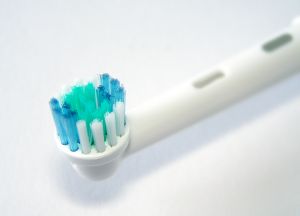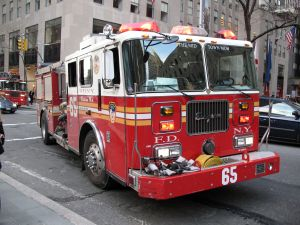 The Federal Drug Administration (FDA) released a Consumer Update on February 16, 2012 warning consumers of multiple issues with the Arm and Hammer Spinbrush (called the Crest Spinbrush before 2009). All nine models of the Spinbrush are being recalled, including the Spinbrush for Kids and the replacement heads themselves.
The Federal Drug Administration (FDA) released a Consumer Update on February 16, 2012 warning consumers of multiple issues with the Arm and Hammer Spinbrush (called the Crest Spinbrush before 2009). All nine models of the Spinbrush are being recalled, including the Spinbrush for Kids and the replacement heads themselves.
The Spinbrush has a removable head which has been known to detach unexpectedly exposing the metal piece to which it is connected. The metal piece has jabbed brushers in the cheek, lips, and even eyes causing multiple injuries. In other cases, the toothbrush head popped off in the mouth, chipping teeth, which, if swallowed constitute a choking hazard. Although the Spinbrush for Kids does not have a removable head, problems have been reported with this model as well. Reportedly, bristles may become loose and detach posing a choking hazard to children. Other reports include cut lips and burns from overheating batteries.
Unfortunately, the Spinbrush has a dogged history. Proctor and Gamble initiated a recall for its Crest Spinbrush in November 2004, admitting that the removable head had detached in a small number of brushes. At that time, there were 7.5 million Spinbrushes were in distribution nationwide. Since then, the number has risen to over 22 million distributed internationally, as cited in the latest recall of the Spinbrush.
In May 2011, the FDA issued a warning letter to Church and Dwight Co. Inc., which manufactures the Spinbrush, admonishing the company for repeatedly failing to file Medical Device Reports within 30 days of being notified about serious mouth injuries and chipped teeth caused by the Spinbrush. Moreover, once the company submitted the late Medical Device Report, it failed to designate the injuries as serious, although chipped teeth, cuts to the mouth and eye, and reports of choking are deemed serious by the FDA’s, and most people’s, standards.
The next recall followed on January 25, 2012 for the same reasons. The FDA’s latest Consumer Update is yet another sign that the problems with the Spinbrush have not been addressed. Church and Dwight Co. Inc. has recently taken actions to remedy the problem with the Spinbrush. It added a label to the packaging warning consumers to change the replacement head every three months to avoid wear that could lead to the head malfunctioning. It also added colored bristles that fade to signal that the replacement head should be changed. Finally, it issued safety notices on television and in print.
California law places strict liability of companies doing business in the state. Manufacturers and distributors that send out defective products are generally liable for harm caused by their products. There are also more specific causes of actions, which may apply to the Spinbrush, including, but not limited to, design defect and consumer expectations and negligence to recall/retrofit.
The California Civil Jury Instructions states that a design can be proved to be defective if it did not perform as safely as an ordinary consumer would have expected it to perform. To establish this claim, a plaintiff must prove all of the following:
- That the defendant manufactured/distributed/sold the product;
-
That, at the time of the use, the product was substantially the same as when it left the defendant’s possession or that any changes made to the product after it left defendant’s possession were reasonably foreseeable to defendant;
-
That the product did not perform as safely as an ordinary consumer would have expected at the time of use; and
-
That the product was used or misused in a way that was reasonably foreseeable to defendant.
The California Civil Jury Instructions states that a plaintiff may claim that the defendant was negligent because defendant failed to recall or retrofit the product. To establish this claim, plaintiff must prove all of the following:
- That defendant manufactured/distributed/sold the product;
-
That defendant knew or reasonably should have known that the product was dangerous or was likely to be dangerous when used in a reasonably foreseeable manner;
-
That defendant became aware of this defect after the product was sold;
-
That defendant failed to recall or retrofit or warn of the danger of the product; and
-
That a reasonable manufacturer/distributor/seller under the same or similar circumstances would have recalled or retrofitted the product.
As with most causes of action, the plaintiff must also prove for both causes of action that:
- That the plaintiff was harmed; and
-
That defendant’s product and/or negligence were a substantial factor in causing plaintiff’s harm.
Continue Reading ›
 San Francisco Injury Lawyer Blog
San Francisco Injury Lawyer Blog


 Most people who are injured on the job look to worker’s compensation to support them while they are unable to work. In some cases there may be another option as well. Raymond Mariolle, a garbage collector for Waste Management, sued the manufacturer of the truck he used at work for product liability and won to the tune of $11.4 million.
Most people who are injured on the job look to worker’s compensation to support them while they are unable to work. In some cases there may be another option as well. Raymond Mariolle, a garbage collector for Waste Management, sued the manufacturer of the truck he used at work for product liability and won to the tune of $11.4 million. The San Francisco Chronicle reported this week on a positive move towards safety in California’s agricultural arena. Manufacturers of methyl iodide, a pesticide used in growing strawberries, have announced that the product will be pulled from the market in California and throughout the United States. Arysta LifeScience Corporation, a Japanese company, has cited economic factors in the decision to discontinue sales. The company has also voluntarily cancelled its registration permitting the sale of methyl iodide in California.
The San Francisco Chronicle reported this week on a positive move towards safety in California’s agricultural arena. Manufacturers of methyl iodide, a pesticide used in growing strawberries, have announced that the product will be pulled from the market in California and throughout the United States. Arysta LifeScience Corporation, a Japanese company, has cited economic factors in the decision to discontinue sales. The company has also voluntarily cancelled its registration permitting the sale of methyl iodide in California.  The Oakland Tribune reported this week that Richmond is joining several area communities in attempting to protect our children and pets from dangerous rodent poisons. The Richmond City Council approved a measure, similar to those already in place in Albany and San Francisco, asking retailers to voluntarily stop sales of certain pest control products. Similar products have already been banned by the federal Environmental Protection Agency. The ban covers particularly toxic formulas as well as loose pellet poisons. In 2008, EPA officials requested that manufacturers re-tool their products so that the poisonous bait is in stations that are inaccessible to children and household pets. Manufacturers were asked to comply by June 2011 but not all makers have done so and the EPA is taking steps to remove the offending products. This process, however, takes time to accomplish and moves like that in Richmond attempt to control the ongoing problem.
The Oakland Tribune reported this week that Richmond is joining several area communities in attempting to protect our children and pets from dangerous rodent poisons. The Richmond City Council approved a measure, similar to those already in place in Albany and San Francisco, asking retailers to voluntarily stop sales of certain pest control products. Similar products have already been banned by the federal Environmental Protection Agency. The ban covers particularly toxic formulas as well as loose pellet poisons. In 2008, EPA officials requested that manufacturers re-tool their products so that the poisonous bait is in stations that are inaccessible to children and household pets. Manufacturers were asked to comply by June 2011 but not all makers have done so and the EPA is taking steps to remove the offending products. This process, however, takes time to accomplish and moves like that in Richmond attempt to control the ongoing problem.  The Federal Drug Administration (FDA) released a
The Federal Drug Administration (FDA) released a Negligently designed or manufactured products are dangerous to all of our residents. Recognizing the danger of defective products and the evidentiary difficulties of these cases, courts use a strict liability theory in
Negligently designed or manufactured products are dangerous to all of our residents. Recognizing the danger of defective products and the evidentiary difficulties of these cases, courts use a strict liability theory in  On January 13, 2012, the National Highway and Traffic Safety Administration announced that KIA Motors America, Inc. noticed a
On January 13, 2012, the National Highway and Traffic Safety Administration announced that KIA Motors America, Inc. noticed a  We hope all the children in your lives were thrilled by the presents that come with Christmas, Hanukah, Kwanza, and other late-in-the-year celebrations. These presents should be the source of smiles and many hours of joy, ideally bringing the family together for an added bit of enjoyment. While we do not wish to set a gray cloud on such happy times, we do want to remind parents to always exercise caution. As
We hope all the children in your lives were thrilled by the presents that come with Christmas, Hanukah, Kwanza, and other late-in-the-year celebrations. These presents should be the source of smiles and many hours of joy, ideally bringing the family together for an added bit of enjoyment. While we do not wish to set a gray cloud on such happy times, we do want to remind parents to always exercise caution. As  As reported in the San Francisco Chronicle, California has just lifted a ban that resulted from concerns about unsafe food products. The ban was issued after five children in our state became ill after drinking raw milk produced by Organic Pastures in Fresno. All of the children were found to have the same strain of E. Coli. Three of the young people were hospitalized with hemolytic uremic syndrome, a dangerous illness that can lead to kidney failure. Although investigators did not find the bacteria in samples of the milk, it was deemed the likely source since all five children had consumed the dairy’s raw milk in the period before they fell ill. The state shut down production at the dairy temporarily and recalled Organic Pastures products. At the time of the Chronicle’s report, the dairy had passed necessary inspections and was allowed to resume production of all products with the exception of raw colostrum. Investigators have continued to quarantine the final product out of concern that it may carry dangerous bacteria.
As reported in the San Francisco Chronicle, California has just lifted a ban that resulted from concerns about unsafe food products. The ban was issued after five children in our state became ill after drinking raw milk produced by Organic Pastures in Fresno. All of the children were found to have the same strain of E. Coli. Three of the young people were hospitalized with hemolytic uremic syndrome, a dangerous illness that can lead to kidney failure. Although investigators did not find the bacteria in samples of the milk, it was deemed the likely source since all five children had consumed the dairy’s raw milk in the period before they fell ill. The state shut down production at the dairy temporarily and recalled Organic Pastures products. At the time of the Chronicle’s report, the dairy had passed necessary inspections and was allowed to resume production of all products with the exception of raw colostrum. Investigators have continued to quarantine the final product out of concern that it may carry dangerous bacteria. The fire sparked in the early morning hours of Tuesday December 6 in a West Oakland duplex. The home, a Victorian-style two-story located at 30th and Chestnut, had recently been remodeled with an apartment on each floor. In addition to displacing three residents, the fire caused at least $30,000 in damages. According to the reports, the fire was caused by faulty chimney construction. The chimney had been built without a flue and the fire started after the upper-level residents used the fireplace in their unit. The embers from the fireplace were unable to exit and sparked a fire in the attic that then spread to the roof. Luckily, no one was injured and a team of twenty firefighters were able to control and extinguish the flames.
The fire sparked in the early morning hours of Tuesday December 6 in a West Oakland duplex. The home, a Victorian-style two-story located at 30th and Chestnut, had recently been remodeled with an apartment on each floor. In addition to displacing three residents, the fire caused at least $30,000 in damages. According to the reports, the fire was caused by faulty chimney construction. The chimney had been built without a flue and the fire started after the upper-level residents used the fireplace in their unit. The embers from the fireplace were unable to exit and sparked a fire in the attic that then spread to the roof. Luckily, no one was injured and a team of twenty firefighters were able to control and extinguish the flames.